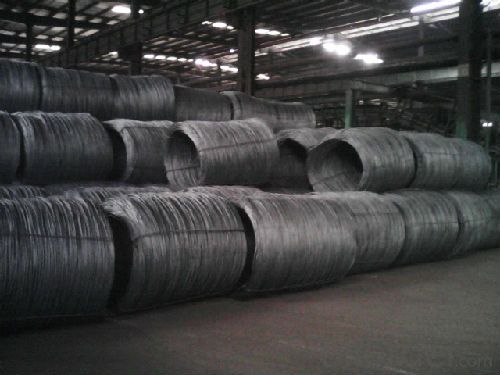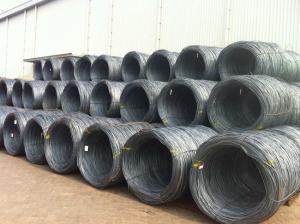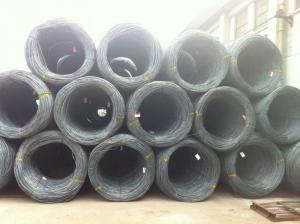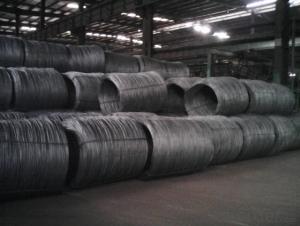Q195 WIRE ROD WITH HIGH QUALITY
- Loading Port:
- China Main Port
- Payment Terms:
- TT or LC
- Min Order Qty:
- -
- Supply Capability:
- -
OKorder Service Pledge
OKorder Financial Service
You Might Also Like
Product Description:
OKorder is offering Q195 WIRE ROD WITH HIGH QUALITY at great prices with worldwide shipping. Our supplier is a world-class manufacturer of steel, with our products utilized the world over. OKorder annually supplies products to European, North American and Asian markets. We provide quotations within 24 hours of receiving an inquiry and guarantee competitive prices.
6.5mm can be drawing into 2mm/8.0mm can be drawing into 3mm
Type: Drawn Wire in Coil, each coil weight about 2MT
Brand Name: N-RIVER Place of Origin: Hebei, China
Chemical Composition:
Please kindly find our chemistry of our material based on Q195 as below for your information
Trademark | Rank | Chemical composition (quality score) % | |||||
C | Si | Mn | S | P | |||
| ≤ |
| ≤ | ≤ | |||
Q195 |
| 0.06-0.12 | 0.30 | 0.25 | 0.050 | 0.045 | |
Trademark | Rank | Pulling Test | |||||
Bend PointΔs/Mpa | Tensile Strength | Elongation Ratioδ5% | |||||
Thickness (Diameter) /MM | Thickness (Diameter) /MM | ||||||
≤16 | 16-40 | ≤16 | 16-40 | ||||
≥ | ≥ | ||||||
Q195 |
| 195 | 185 | 315-390 | 33 | 32 | |
Product Applications:
Q195 WIRE ROD WITH HIGH QUALITY are ideal for structural applications and are widely used in the construction of buildings and bridges, and the manufacturing, petrochemical, and transportation industries.
Product Advantages:
OKorder's Q195 WIRE ROD WITH HIGH QUALITY are durable, strong, and resist corrosion.
Main Product Features:
· Premium quality
· Prompt delivery & seaworthy packing (30 days after receiving deposit)
· Corrosion resistance
· Can be recycled and reused
· Mill test certification
Product Specifications:
Diameter: 5.5mm, 6.5mm, 7mm,8mm,9mm,10mm,12mm,14mm
FAQ:
Q1: What makes stainless steel stainless?
A1: Stainless steel must contain at least 10.5 % chromium. It is this element that reacts with the oxygen in the air to form a complex chrome-oxide surface layer that is invisible but strong enough to prevent further oxygen from "staining" (rusting) the surface. Higher levels of chromium and the addition of other alloying elements such as nickel and molybdenum enhance this surface layer and improve the corrosion resistance of the stainless material.
Q2: How do we guarantee the quality of our products?
A2: We have established an advanced quality management system which conducts strict quality tests at every step, from raw materials to the final product. At the same time, we provide extensive follow-up service assurances as required.
Q3: Can stainless steel rust?
A3: Stainless does not "rust" as you think of regular steel rusting with a red oxide on the surface that flakes off. If you see red rust it is probably due to some iron particles that have contaminated the surface of the stainless steel and it is these iron particles that are rusting. Look at the source of the rusting and see if you can remove it from the surface.
Images:


- Q:What are the main factors influencing the choice of steel wire rod technical support?
- The choice of technical support for steel wire rod production can be influenced by various factors depending on the specific needs and requirements of the industry or company. However, there are several common factors that play a significant role in the decision-making process. One key factor is the expertise and knowledge of the support provider. It is important for the chosen technical support team to have a deep understanding of steel wire rod production processes, equipment, and technologies. They should possess the necessary experience and expertise to offer guidance and solutions for any technical challenges that may arise during production. Another important factor is the reliability and responsiveness of the technical support team. Given that steel wire rod production processes can be time-sensitive, any technical issues or breakdowns can result in costly production delays. Therefore, having a responsive technical support team that can quickly address and resolve any issues is crucial to ensure a smooth and uninterrupted production. The availability of comprehensive technical support services is also a significant factor to consider. This includes not only troubleshooting and resolving technical issues, but also providing guidance and assistance in areas such as process optimization, equipment maintenance, and quality control. A comprehensive technical support provider can take a holistic approach to enhancing the overall efficiency and productivity of the steel wire rod production process. Cost is another important consideration. Companies need to evaluate the cost-effectiveness of the technical support services offered. This involves considering factors such as the upfront cost of the support, ongoing maintenance expenses, as well as the potential cost savings or productivity improvements that can be achieved through the use of the support services. Furthermore, the reputation and track record of the technical support provider are crucial factors to consider. It is essential to choose a provider with a proven track record of delivering high-quality technical support services to ensure reliability and effectiveness. Lastly, the compatibility and integration of the technical support services with the existing infrastructure and systems should be evaluated. The chosen support provider should be capable of seamlessly integrating their services into the existing production processes and systems, minimizing disruptions and maximizing efficiency. In conclusion, the choice of steel wire rod technical support is influenced by factors such as technical expertise, reliability and responsiveness, comprehensive services, cost-effectiveness, reputation, and compatibility. Considering these factors will enable companies to make an informed decision that meets their specific needs and requirements.
- Q:How is the dimensional accuracy of steel wire rod ensured?
- The dimensional accuracy of steel wire rod is ensured through rigorous quality control measures. This includes using precision equipment and techniques for measuring and monitoring the diameter, roundness, and surface finish of the wire rod. Regular inspections are conducted at various stages of the manufacturing process to identify any deviations from the specified dimensional tolerances. Additionally, proper maintenance and calibration of the production machinery play a critical role in ensuring consistent and accurate dimensions of the steel wire rod.
- Q:How is steel wire rod used in the production of wire for suspension bridge cables?
- Steel wire rod is a crucial component used in the production of wire for suspension bridge cables. The wire rod is made from high-quality steel and is typically produced through a process called hot rolling. To create wire for suspension bridge cables, the steel wire rod undergoes several stages of processing. Firstly, the wire rod is heated and then passed through a series of rollers, which gradually reduce its size and shape it into a long, continuous wire. This process is known as wire drawing. The resulting wire is then further processed to enhance its strength and durability. It undergoes a heat treatment process, such as annealing, to improve its mechanical properties. This treatment helps increase the wire's tensile strength, ensuring it can withstand the immense loads and stresses experienced by suspension bridge cables. Once the wire has been appropriately treated, it is then carefully woven and braided to create the final suspension bridge cable. Multiple wires are twisted together to form strands, and several strands are then twisted together to create a larger cable. This intricate weaving process ensures that the cable is strong, flexible, and resistant to corrosion. The use of steel wire rod in the production of suspension bridge cables is crucial due to its exceptional strength-to-weight ratio. Steel is renowned for its high tensile strength, making it an ideal material for supporting heavy loads over long spans. Additionally, steel wire rod offers excellent resistance to corrosion, ensuring the longevity and structural integrity of suspension bridge cables. Overall, steel wire rod plays a vital role in the production of wire for suspension bridge cables, providing the necessary strength, durability, and flexibility required for these critical infrastructure components. Its versatility and reliability make it a preferred material choice in the construction of suspension bridge cables, ensuring the safety and functionality of these impressive engineering marvels.
- Q:How is steel wire rod used in the manufacturing of wire rope assemblies for lifting?
- The manufacturing of wire rope assemblies for lifting requires steel wire rod as an essential component. These wire rope assemblies find extensive use in industries like construction, mining, and oil and gas sectors for lifting heavy loads. The primary purpose of steel wire rod is to serve as the raw material for producing wire ropes. These wire ropes consist of multiple strands of steel wires twisted together. They are renowned for their exceptional strength, durability, and flexibility, making them suitable for demanding lifting applications. The manufacturing process of steel wire rod involves several stages. Initially, the rod undergoes hot rolling to shape it into a long, continuous wire. This wire then undergoes cold-drawing, where its diameter is reduced and strength is increased. Subsequently, the cold-drawn wire is annealed to enhance its ductility and flexibility. Once the wire is prepared, it is twisted into strands and helically laid around a central core, forming the wire rope. The number of strands and arrangement of wires within each strand can vary according to specific application requirements. The individual wires within the strands are engineered with precision to ensure even load distribution and maximize the wire rope's strength. The properties of steel wire rod, such as high tensile strength and excellent corrosion resistance, play a vital role in the performance and reliability of wire rope assemblies. The wire rope's strength enables it to withstand heavy loads, while its corrosion resistance makes it suitable for use in challenging environments like marine or offshore applications. In conclusion, steel wire rod is crucial in the manufacturing of wire rope assemblies for lifting due to its exceptional strength, durability, and resistance to corrosion. It forms the foundation for creating wire ropes capable of safely and efficiently lifting heavy loads in various industries.
- Q:How is steel wire rod used in the manufacturing of wire mesh shelves?
- Steel wire rod is used in the manufacturing of wire mesh shelves by being processed and formed into wire mesh grids through welding or weaving techniques. These wire mesh grids serve as the primary structural component of the shelves, providing strength and stability. The steel wire rod is chosen for its high tensile strength and durability, ensuring that the wire mesh shelves can withstand heavy loads and resist bending or warping.
- Q:What are the common customer requirements for steel wire rod?
- Some common customer requirements for steel wire rod include high tensile strength, consistent quality, good surface finish, precise dimensional accuracy, and compliance with industry standards and specifications. Customers often look for wire rod that is suitable for various applications such as automotive parts, construction materials, and wire products. Additionally, timely delivery, competitive pricing, and excellent customer service are also important considerations for customers.
- Q:How is steel wire rod used in the manufacturing of wire for heating elements?
- Steel wire rod is an essential component in the manufacturing of wire for heating elements. It serves as the primary raw material used to create the wire that forms the heating element. The process starts with high-quality steel wire rod that is carefully selected based on its specific properties and characteristics. This rod is then subjected to a series of manufacturing processes to transform it into wire suitable for heating elements. First, the steel wire rod is carefully drawn through a series of dies to reduce its diameter. This drawing process helps to refine the wire and achieve the desired diameter and uniformity. It also improves the mechanical properties of the wire, ensuring it can withstand the high temperatures and stresses that heating elements are subjected to. Next, the wire is typically subject to annealing, which involves heating it to high temperatures and then slowly cooling it. This process helps to relieve any internal stresses in the wire and improve its ductility, making it easier to work with during the subsequent steps of manufacturing. Once the wire has been drawn and annealed, it is further processed to add any necessary coatings or surface treatments. These coatings can provide additional protection against corrosion, enhance the wire's electrical conductivity, or improve its heat resistance, depending on the specific requirements of the heating element. Finally, the wire is spooled onto large reels, ready to be used in the manufacturing of heating elements. These spools of wire can then be further processed and shaped to create the specific design required for the heating element, whether it be a coil, ribbon, or other form. Overall, steel wire rod plays a crucial role in the manufacturing of wire for heating elements. It serves as the foundation for creating the wire that will ultimately generate heat in a wide range of applications, from household appliances to industrial equipment. Its high-quality properties, combined with the careful manufacturing processes it undergoes, ensure that the wire meets the strict requirements for performance, durability, and safety in heating element applications.
- Q:What are the different types of steel wire rod surface defects and their impact?
- There are several different types of surface defects that can occur on steel wire rods, each with their own unique impact on the quality and performance of the product. The following are some of the most common types of defects and their corresponding impacts: 1. Scale: Scale is a type of oxide layer that forms on the surface of steel during the manufacturing process. It can appear as a thick, flaky layer or as a thin, tightly adhered coating. Scale can negatively impact the surface finish of the wire rod and reduce its corrosion resistance. 2. Pits: Pits are small depressions or cavities on the surface of the wire rod. They can be caused by impurities or inclusions in the steel or by mechanical damage during processing. Pits can reduce the strength and integrity of the wire rod, making it more susceptible to failure under stress. 3. Scratches and gouges: Scratches and gouges are physical marks on the surface of the wire rod, typically caused by handling or contact with abrasive surfaces. These defects can create stress concentration points and weaken the wire rod, leading to a higher risk of fracture or breakage. 4. Laps and seams: Laps and seams are discontinuities or irregularities in the surface of the wire rod, often caused by improper rolling or handling. These defects can affect the dimensional accuracy of the wire rod and reduce its overall strength and ductility. 5. Decarburization: Decarburization is the loss of carbon from the surface layer of the wire rod, typically due to exposure to high temperatures during processing. This can result in a softer and weaker surface layer, leading to reduced wear resistance and fatigue strength. 6. Corrosion: Corrosion is the deterioration of the wire rod's surface due to chemical reactions with the environment. It can occur in the form of rust or other types of oxidation. Corrosion can significantly reduce the lifespan and performance of the wire rod, particularly in applications where the rod is exposed to moisture or corrosive substances. Overall, these surface defects can have a detrimental impact on the quality, strength, and durability of steel wire rods. Proper quality control measures and inspection techniques are essential to identify and mitigate these defects to ensure that the wire rods meet the desired specifications and perform optimally in their intended applications.
- Q:What are the different types of steel used for manufacturing wire rod?
- There are various types of steel used for manufacturing wire rods, including carbon steel, alloy steel, stainless steel, and tool steel. Each type has its own distinct properties and characteristics that make it suitable for specific applications.
- Q:How is steel wire rod used in the manufacturing of wire for automotive fuel injection systems?
- Steel wire rod is an essential component in the manufacturing of wire for automotive fuel injection systems. This high-quality steel wire is used to create the various wires and cables required for these systems. One of the primary uses of steel wire rod in the manufacturing process is for the production of fuel injector wiring harnesses. These harnesses are responsible for connecting the fuel injectors to the vehicle's electronic control unit (ECU). The steel wire rod is drawn into thin and precise wires that are then braided or twisted together to form the necessary harnesses. The steel wire rod used in this process is chosen for its exceptional strength, durability, and electrical conductivity. It must be able to withstand the harsh conditions under the hood of a vehicle, including high temperatures, vibrations, and exposure to chemicals. Additionally, steel wire rod is also used in the manufacturing of other wires and cables within the fuel injection system. These include sensor cables, which transmit data from various sensors to the ECU, and power cables, which provide electrical power to the fuel injectors. Overall, steel wire rod plays a crucial role in the manufacturing of wire for automotive fuel injection systems. Its strength, durability, and electrical conductivity ensure the proper functioning and longevity of these systems, ultimately contributing to the performance and efficiency of the vehicle.
1. Manufacturer Overview |
|
|---|---|
| Location | |
| Year Established | |
| Annual Output Value | |
| Main Markets | |
| Company Certifications | |
2. Manufacturer Certificates |
|
|---|---|
| a) Certification Name | |
| Range | |
| Reference | |
| Validity Period | |
3. Manufacturer Capability |
|
|---|---|
| a)Trade Capacity | |
| Nearest Port | |
| Export Percentage | |
| No.of Employees in Trade Department | |
| Language Spoken: | |
| b)Factory Information | |
| Factory Size: | |
| No. of Production Lines | |
| Contract Manufacturing | |
| Product Price Range | |
Send your message to us
Q195 WIRE ROD WITH HIGH QUALITY
- Loading Port:
- China Main Port
- Payment Terms:
- TT or LC
- Min Order Qty:
- -
- Supply Capability:
- -
OKorder Service Pledge
OKorder Financial Service
Similar products
New products
Hot products
Related keywords





























